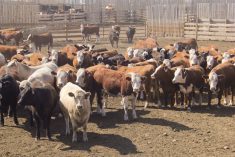Chicago | Reuters — Chicago Board of Trade wheat futures jumped nearly four per cent on Friday as a drone attack on Moscow revived concerns over the risk of war disruptions to Black Sea grain exports, analysts said.
Soybean futures advanced for a third session to reach a July high as a hot, dry U.S. weather forecast fuelled worries about crop stress. Corn futures also finished higher.
Grain traders have been nervous that escalating tensions between Russia and Ukraine could disrupt Black Sea crop shipments since Moscow quit the U.N.-backed export deal for Ukraine in July. Both countries are major grain exporters.
Read Also

U.S. livestock: Feeder cattle hit contract highs on tight supply
Chicago | Reuters – All Chicago Mercantile Exchange feeder cattle futures and most live cattle futures hit contract highs on…
On Friday, a Ukrainian drone smashed into a building in central Moscow after Russian air defenses shot it down, Russian officials said.
Most-active wheat futures ended up 23-3/4 cents at $6.39 a bushel at the CBOT (all figures US$). Earlier this week, the contract hit its lowest price since June 1.
“Wheat-wise, we got a little bit overdone to the downside,” said Matt Wiegand, commodity broker for FuturesOne.
CBOT soybeans finished 23-1/4 cents higher at $13.53-1/4 a bushel and touched their highest price since July 31. Corn rose 7-1/4 cents to $4.93 a bushel.
Traders covered short positions in the soy and corn markets ahead of the weekend, traders said, with weather forecasts showing little rain and hotter temperatures for the rest of August in the U.S. Midwest. Soybeans are seen as more vulnerable to potential damage because August is the crop’s critical month for development.
“There’s going to be a significant amount of acres that are vulnerable to stress,” Wiegand said.
The shift in weather helped markets recover after corn fell to a December 2020 low this week.
Next week, traders will assess findings of the annual Pro Farmer crop tour, which will examine corn and soybean fields across the Midwest.
“Just as it looked as if it had turned all plain sailing for U.S. corn and soybean farmers,” consultancy CRM Agri said in a note, “the weather outlook has turned more hostile again.”
— Reporting for Reuters by Tom Polansek in Chicago; additional reporting by Gus Trompiz in Paris and Naveen Thukral in Singapore.
















